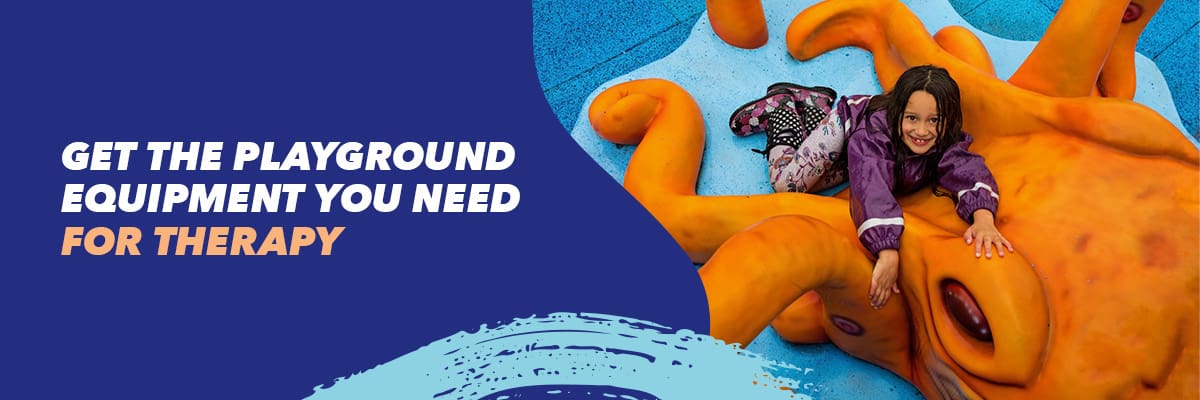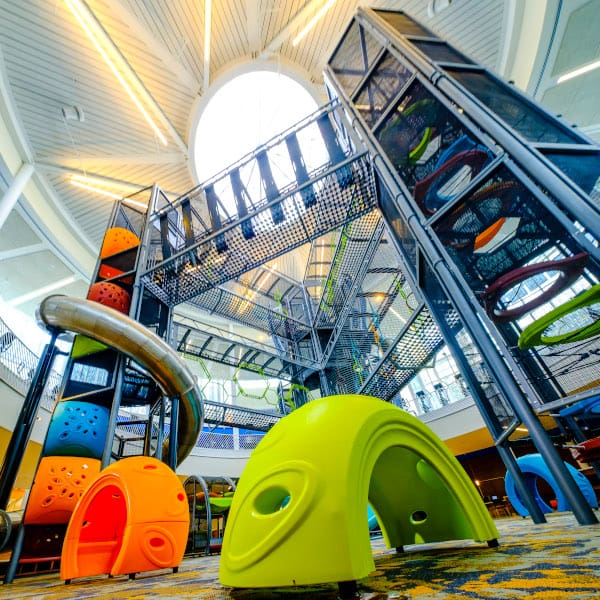Benefits of Playground Equipment for Therapy

Benefits of Playground Equipment for Therapy
As a therapist, you use various tools and techniques to help your clients work through their emotional, behavioral or physical issues. Many kids can’t express their feelings in the same way adults can. If kids have certain mental or physical disabilities, they need appropriate ways of coping with and overcoming their difficulties.
Playground therapy is an effective way for therapists to help kids navigate their challenges and gain the skills to conquer them. Learn about the benefits of playground equipment for therapy and how you can utilize it in your treatments.
Read the full article or jump to a specific section:
- What Is Playground Therapy?
- Who Is Playground Therapy For?
- The Benefits of Playground Therapy
- Indoor vs. Outdoor Playground Therapy
- Best Equipment for Playground Therapy
- What Equipment Soft Play® Offers for Playground Therapy
- Get the Playground Equipment You Need for Therapy
What Is Playground Therapy?
Playground therapy is a type of play therapy, which many therapists in schools, clinics and hospitals use to help kids overcome their behavioral and physical difficulties. According to the Centers for Disease Control and Prevention (CDC), play therapy enables kids to communicate their feelings through play. Playground therapy also helps kids with physical disabilities develop the strength and mobility to accomplish certain tasks.
Having the skills to express oneself through language is vital for development. When someone can identify their feelings, it’s much easier for a behavioral or occupational therapist to help them practice a solution. For young kids, this kind of communication is nearly impossible. Specific mental or physical disabilities make it even more challenging for kids to explain their feelings.
Playground equipment therapy works similar to talk therapy — both kinds of treatment allow the client to express themselves freely so the therapist can discover solutions. Typically, kids playground therapy involves these elements:
- Freedom to move: Kids can play and act out their experiences in a safe, non-judgmental environment that suits their ability level.
- Observation: Therapists observe clients’ behavior to identify issues and determine an appropriate treatment, noting their facial expressions, words, actions and preferences.
- Engagement: As kids play, they engage with their therapists and build a relationship where they express their feelings freely. Therapists may use talking and creative activities to help kids express themselves.
Who Is Playground Therapy For?
Play therapy has become a common practice partly because of its versatility. Playground therapy can help:
Kids With Behavioral Issues
The CDC notes that therapists use play therapy to help kids with behavioral issues like attention-deficit/hyperactivity disorder (ADHD). Kids with ADHD often display behavioral problems that playground therapy can help them recognize and learn to manage. Playground therapy can help kids with these and other ADHD symptoms:
- Inability to focus
- Hyperactivity
- Difficulty organizing tasks
This form of play therapy also helps kids with other behavioral and emotional difficulties like:
- Disruptive behavior disorder
- Depression
- Anxiety
- Post-Traumatic Stress Disorder (PTSD)
Kids Recovering From Illness
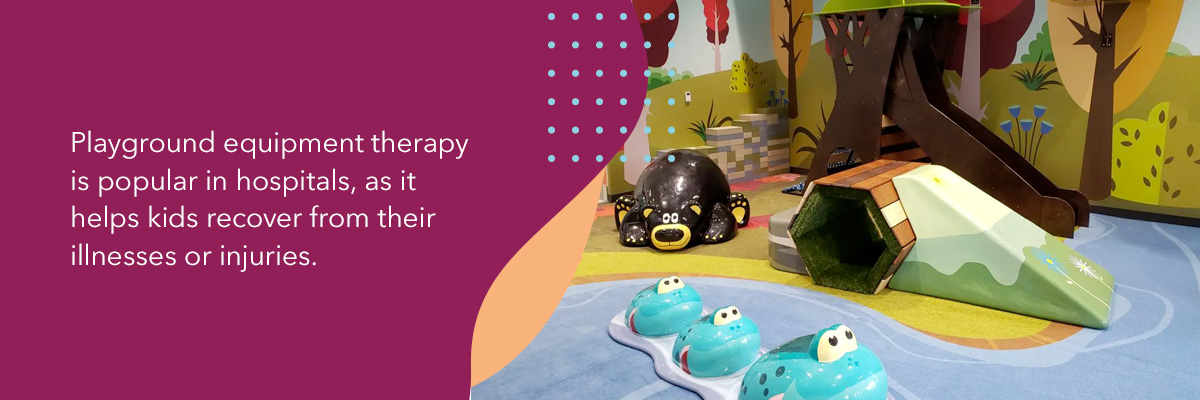
Playground equipment therapy is popular in hospitals, as it helps kids recover from their illnesses or injuries. Therapeutic play in hospitals provides benefits like:
- Physical recovery and development like strength-building
- Anxiety management and coping
- Expression of kids’ fears and feelings about their hospitalization
Kids With Physical Disabilities
Kids with mobility issues still need to practice using their muscles whenever they are able. Utilizing playground equipment for therapy allows these kids to move their bodies to develop muscle strength and practice fine motor skills. By engaging with their environment in a way they are generally not able to, kids have the chance to reach new physical achievements.
Kids With Delayed Development
Playground equipment therapy also benefits kids with delayed development, whether in social skills, academics or physical coordination. Therapists can use playground therapy to treat kids with:
- Reading difficulties
- Lack of social development
- Coordination issues
- Speech and language delays
The Benefits of Playground Therapy
If you’re considering adding a playground to your facility, it’s vital to know how it can benefit your clients. Consider these primary benefits of playground therapy:
1. Improved Communication
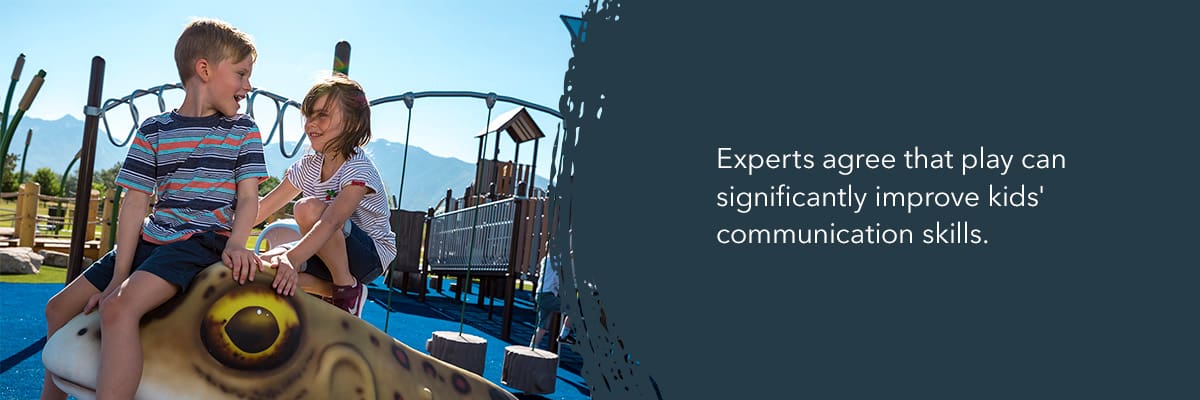
Playing in a safe space can empower kids to communicate physically and verbally. Experts agree that play can significantly improve kids’ communication skills. When therapists accept kids as they are and allow them to play freely, it creates a safe space where kids can experience and explore their feelings.
Learning how to communicate their feelings also helps kids grow socially. When kids work through their mental, emotional and behavioral issues with a therapist’s help, they can gain the skills to communicate their feelings with others and make friends.
2. Enhanced Physical Development
Playground therapy can also promote physical development and healing for kids, especially those who have been hospitalized or face physical disabilities. Older kids need at least 60 minutes of exercise every day, while kids ages 3-5 need to be active throughout their day. Health and wellness become difficult when kids are in and out of hospital rooms and doctors’ offices or have limited mobility.
Through playground equipment therapy, therapists provide an opportunity for these kids to be more fit and strong. Playing on playground equipment allows kids to improve their:
- Core, upper body and lower body strength
- Bone density
- Flexibility
- Muscle control
- Heart and lung function
3. Boosted Confidence
Play helps kids develop emotional resilience, social competence and self-esteem. When kids push themselves to try new types of movement and succeed, they gain the confidence and skills to continue navigating unfamiliar situations and social scenarios.
Playground therapy also equips kids with the social skills necessary to succeed as adults. Through creativity, problem-solving and communication in play, kids grow emotionally and develop better social skills. Consistent playground therapy in a comforting, safe environment enhances kids’ self-esteem by giving them:
- The chance to just be a kid
- An opportunity to work through their emotions
- Skills to handle future challenges
4. Trauma Recovery
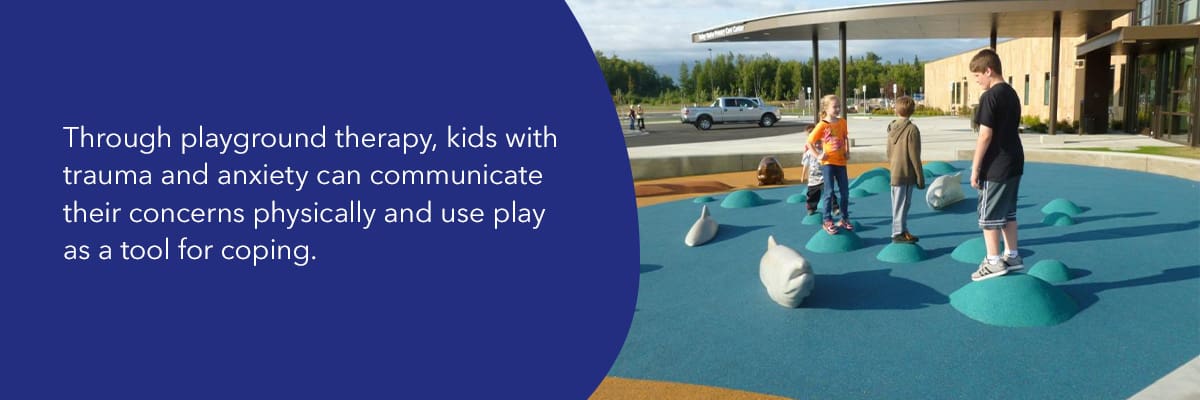
Playground therapy can also help kids with anxiety, PTSD or other trauma. Recovering from trauma is a challenging process for adults, let alone for kids with physical or communication difficulties. Often, kids who have experienced a traumatic event struggle to speak about it. Through playground therapy, kids with trauma and anxiety can communicate their concerns physically and use play as a tool for coping.
Playground equipment therapy can be helpful to kids dealing with difficult situations like:
- Grief
- Divorce of their parents
- Relocation
- Hospitalization
- Abuse or violence
- Natural disasters
Indoor vs. Outdoor Playground Therapy
Therapists can use playground therapy indoors or outdoors. Many occupational therapy offices, clinics and hospitals have indoor playgrounds within their facilities. Trained playground therapists can also utilize outdoor playground equipment for therapy sessions.
Although outdoor playgrounds are popular in many play scenarios and bring several benefits, indoor playgrounds are usually better and easier for playground therapy purposes. Consider the benefits of each type of playground therapy to determine which is best for your practice:
Outdoor Playground Therapy
Playing outdoors exposes children to a wide variety of sensory experiences. Besides the fact that playing in nature is just fun, outdoor playground therapy also provides several benefits to kids:
- Health benefits: Being out in nature provides a host of health benefits, from lower stress and improved attention to increased levels of vitamin D.
- Cognitive benefits: Outdoor play also increases cognitive function. One study found that having green space at home and school helped kids focus and develop self-control.
- Emotional benefits: Being in outdoor spaces also helps kids develop healthy emotional patterns and decreases their risk of behavioral issues like eating disorders, mood disorders and substance use disorders.
Indoor Playground Therapy
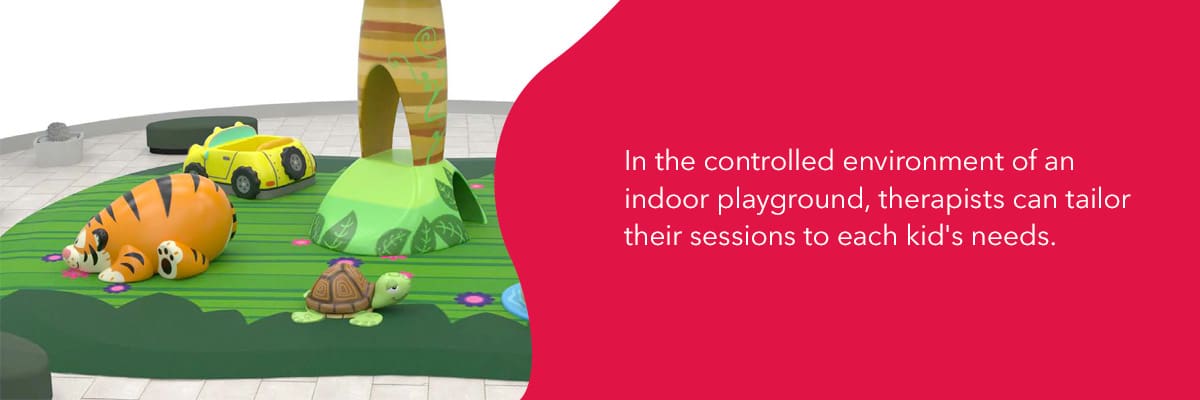
These benefits of indoor playground therapy often make it the best choice for therapists:
- Variety: Kids coming to playground therapy may have diverse physical and sensory needs. In the controlled environment of an indoor playground, therapists can tailor their sessions to each kid’s needs.
- Flexibility: Indoor playgrounds have the advantage of being usable at all times. Whether it’s snowing or dark outside, therapists can still use indoor playground equipment for therapy.
- Convenience: With soft and uniform playground surfacing, kids of different abilities can easily navigate throughout your indoor playground space. Indoor playgrounds are also more accessible to kids with mobility issues.
- Maintenance: Indoor playground equipment for therapy is protected from rain, sun and heat, so they will likely last longer than outdoor equipment. Sanitation is also easier.
- Designated spaces: Installing an indoor playground lets your facility maximize space and create special areas for kids of different abilities. An indoor play area also makes it easier for therapists and parents to keep an eye on kids.
Best Equipment for Playground Therapy
Effective kids playground therapy requires a professional therapist who can direct and help kids as they play. Therapists benefit from having the right tools and equipment at their disposal. How do you choose the right indoor playground equipment for therapy? Here’s some inspiration to help you bring your vision to life:
Slides
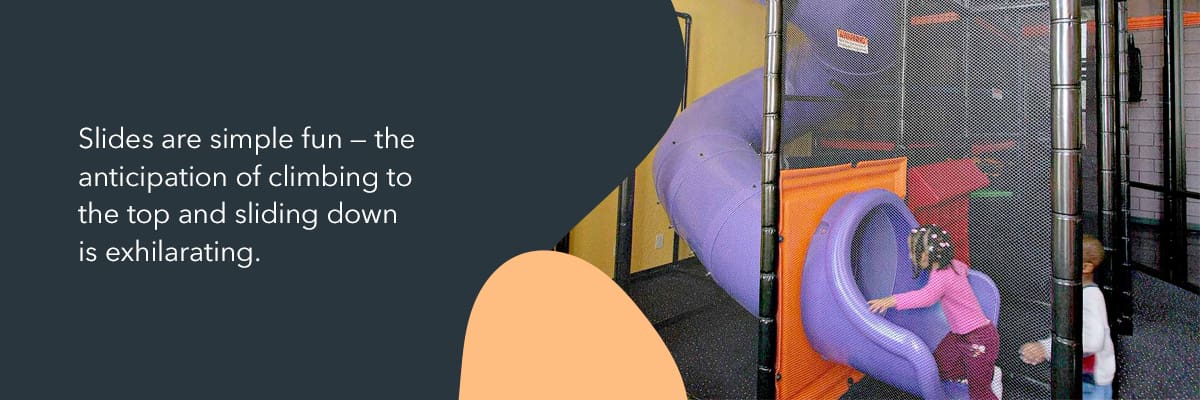
Playground slides are one of the most beloved types of playground equipment. Slides are simple fun — the anticipation of climbing to the top and sliding down is exhilarating. Using a slide in your playground equipment therapy benefits your clients. Check out why indoor playground slides are an excellent addition to a playground for treatment:
- Promote physical strength: Using a slide improves a kid’s core and upper body strength. Kids need to use these muscles to climb to the top and hold themselves upright as they slide.
- Improve vestibular skills: Kids use vestibular skills to keep their balance and maintain their posture during play. These skills are essential for all kinds of physical movement. Improving their vestibular skills is especially vital for kids with mobility or developmental issues.
- Improve social skills: Taking turns on the slide requires that kids communicate with one another, developing critical social skills to benefit them throughout life. Everyone can’t slide simultaneously, so kids also have to problem-solve to decide who gets to take their turn and when.
Swings
Swinging is another popular activity in playground equipment therapy. The design of swings has become incredibly diverse, with swings available in several configurations to support kids of all abilities. For instance, some types of swings help kids with limited mobility enjoy the sensation of swinging without needing to transfer out of their wheelchairs. Other kinds of swings help kids improve their coordination.
Swings benefit kids in playground therapy by:
- Improving physical strength and control: Swinging helps develop core strength and fine motor skills by encouraging hand-eye coordination and spatial orientation. Some indoor playground equipment like swinging platforms also enables kids to shift their weight as they swing, giving them greater opportunities to develop strength.
- Increasing balance: Kids of all ability levels benefit from swings in indoor playground therapy, but kids with certain developmental and behavioral difficulties might find the movement especially beneficial. For example, kids on the autism spectrum often have delayed movement skills and may struggle with coordination. Swinging can help their brains connect cause and effect, improving their ability to control their bodies.
- Easing sensory overload: Kids with sensory sensitivity, such as those on the autism spectrum, often experience an overload of sensory stimulation. Swinging can help these kids process what they experience by integrating the senses and eliminating disruptions.
Foam Pit
For many kids, wading through a foam pit is a fun adventure — but the experience also provides many benefits. Jumping in and climbing out of a foam pit requires several muscle groups, including the lower body and core. When therapists want kids to improve their physical strength and coordination, helping them navigate a foam pit is an excellent option that involves little risk.
A foam pit offers kids unique sensory stimulation. This playground feature contains foam cubes that provide a gentler and quieter sensory experience. The sensory input of being surrounded by foam can either excite or soothe kids, depending on their mood and therapy techniques used.
Overwhelming sensory input can cause nervousness and other issues in kids with sensory processing disorders. In playground equipment therapy, therapists can use a foam pit to help kids calm down when they feel anxious. A foam pit can also serve as a reward when a kid accomplishes another more difficult task or activity.
Soft Sculpted Foam
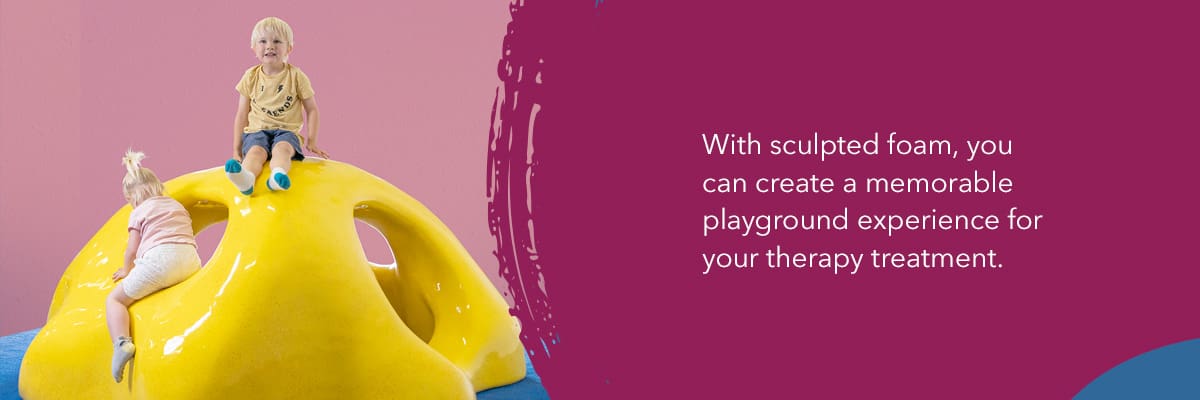
Including soft sculpted foam structures in your indoor playground gives kids the opportunity to expand their creativity and play in a world of their own imagination. With sculpted foam, you can create a memorable playground experience for your therapy treatment. Some of the benefits of including sculpted foam structures in kids playground therapy are:
- Flexibility: Sculpted foam structures allow for solitary or collaborative play. Whether you are only working with one client at a time or are observing several kids at once, sculpted foam structures make room for all.
- Accessibility: Sculpted foam structures are also accessible for kids of all abilities. Kids can climb in and on these foam structures. Kids using wheelchairs can play around these structures and use them in their make-believe. These elements also give parents and therapists easy visibility into kids’ activities.
- Versatile play: Handcrafted sculpted foam structures have virtually endless design options. Sculptures can be nearly realistic and resemble animals, rocks, cars or other structures. You can also include abstract foam sculptures with vibrant colors and interesting shapes. Sculpted foam structures offer a wide range of fun, enabling kids to let their imaginations soar.
Rock Walls
Another excellent option for playground equipment for therapy is a rock wall or climbing wall. Climbing hand-over-hand to reach the top of a rock wall involves using the upper body, lower body and core, strengthening all these muscle groups.
Rock walls also help kids improve their ability to:
- Balance and shift their weight
- Coordinate movements between their hands, eyes and feet
- Plan and sequence actions
Some kids with physical disabilities may not be able to climb up a rock wall. In this situation, custom playground equipment for therapy can be the perfect solution. Therapists can include accessible rock walls with wider footholds or handholds that allow the kids to use their upper bodies exclusively.
Mats

Core strength is essential for many skills needed later in life, including writing, sitting at a desk and climbing stairs. Many kids with physical and mental disabilities have low core strength and need a structured environment to practice movements that can help them grow stronger. When muscle tone is low, practicing movement and exercises on a soft mat is an excellent solution.
Mats are essential to indoor playground therapy. Using a mat can help kids with behavioral, mental and physical disabilities learn to perform basic functions like sitting, walking, crawling and more. Mat exercises can also help kids develop their fine motor skills and coordination.
To use mats in a playground therapy setting, the therapist assesses what actions the client wants to learn to perform. Then the therapist brings the client to a mat and encourages them to practice movements like crawling through a tube, sitting up and moving their arms and legs while lying down. Playground therapists have a wide range of activities to practice with kids as they build their strength.
What Equipment Soft Play® Offers for Playground Therapy
When adding indoor playground equipment for therapy to your facility, partner with Soft Play to design a playground that fits your needs and those of your clients. At Soft Play, we offer a wide range of playground elements and structures therapists can use for play therapy. Our structures are durable, easy to clean and customizable for any theme.
Check out our selection of play equipment for playground therapy:
1. Custom Slides
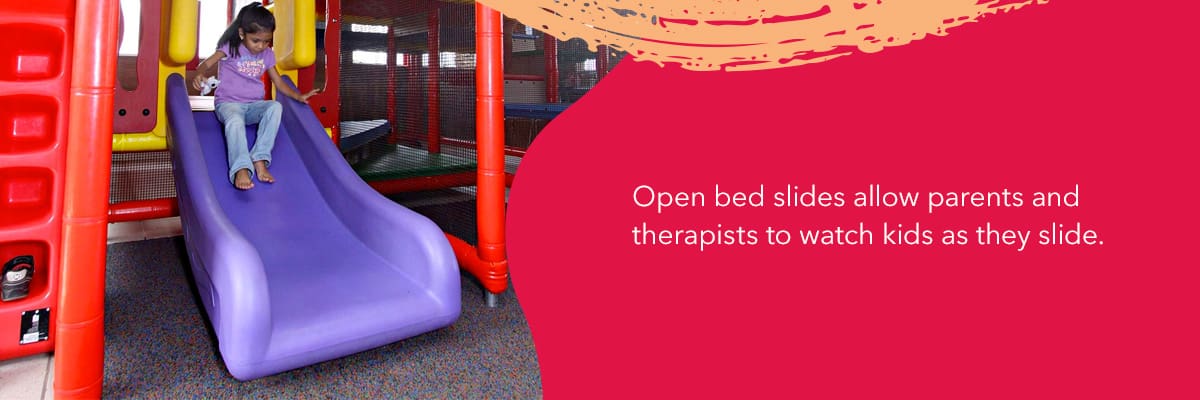
At Soft Play, we provide a range of slides for kids of all ability levels. For example, open bed slides allow parents and therapists to watch kids as they slide. Kids can look around them as they slide down these slides, which can help kids with sensory processing disorders or those who don’t enjoy enclosed spaces.
We also offer complete customization of playground slides. Installing a custom slide enables you to serve your clients specifically. Kids with mobility issues may be able to use an accessible slide with side rails to pull themselves up from the exit point and slide down without needing to use stairs. You can also design a slide that gives therapists and parents better visibility of kids as they play.
2. Elementz
At Soft Play, we have over 20 years of experience crafting sculpted foam structures. These sculptures are an excellent option for playground therapy because of their accessibility and versatility. Therapists can watch kids as they play freely on or around the sculptures, observing how they interact with peers and the sculpture itself. Climbing on the sculptures also builds muscle strength, while kids with sensory sensitivity might enjoy sitting beneath them for some relaxation.
You can select foam sculptures from our current designs or create elements for your unique needs. A popular option for hospitals, clinics and other therapy centers is our Elementz line of foam sculptures. These sculptures include ramps, tunnels and climbing elements that help kids use their gross motor skills. The Elementz line also features a modern design that can suit any space.
3. Play Towers
Play towers encourage active play, which improves a kid’s overall health and can reduce anxiety. The versatility of play tower structures enables facilities to design the perfect playground for their clients. Kids will also enjoy the freedom to play in multiple ways, explore their space and climb up into the structure. Play towers include elements like:
- Bridges
- Activity panels
- Nets
- Platforms
- Rope climbing
- Horizontal and vertical rollers
- Slides
- Wheel spinners
4. STOMP
STOMP is a gamified play element that allows multiple kids to compete in jumping and stomping their way to the highest score. The interactive experience gets kids moving and improves their balance and gross motor skills while having fun.
Some kids might enjoy less action or could become overstimulated by STOMP’s lights and element of competition. For other kids, STOMP provides a much-needed fast pace and a fun level of interaction. Therapists can assess their clients to determine whether playing on STOMP is right for them.
Get the Playground Equipment You Need for Therapy
Help your therapy business attract more clients and serve them better with playground elements for therapy from Soft Play. We understand that every facility has unique needs and one playground doesn’t fit all. That’s why Soft Play playground equipment is customizable for different spaces, budgets and ability levels.
Whether you’re helping kids develop their muscle strength or learn to cope with and express their emotions, you can find Soft Play equipment to help. Learn more about the Soft Play difference or contact us today for a free design consultation.
